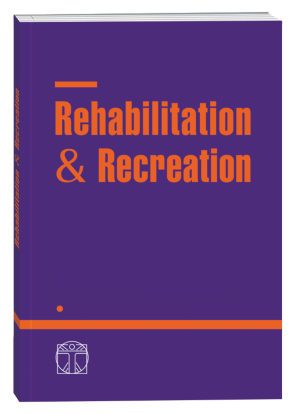PHYSICAL ACTIVITY AND FORMS OF SPENDING FREE TIME FOR CHILDREN
DOI:
https://doi.org/10.32782/2522-1795.2022.13.18Keywords:
physical activity, children, health, education, lifestyle.Abstract
Free time performs many important functions at every stage of human development, although it is usually devoted to rest and self-realization. In the literature on the subject, you can find numerous definitions of free time, and their common denominator is the impact on the holistic development of a human being. One of the key functions of free time is rest and recreation, and thus – physical activity. Regular physical activity determines the quality and length of a person's life. Properly selected activity also enriches the intellectual sphere and allows you to maintain a balance between the condition of the body and the state of mind. It contributes to a better psychophysical condition, as well as to better well-being. Physical activity is extremely important for the proper development of an individual, especially when modern society is exposed to a sedentary lifestyle. Playing sports and systematic movement outdoors are not only of many benefits for the individual, but also for the entire society. A healthy society lives longer, is more productive and, above all, is aware of a healthy lifestyle. Physical activity is therefore an important factor in shaping health, healthy habits, but also valuable spending free time. Participation in physical culture can take place in various ways: from active forms carried out by participation in broadly taken forms of movement to passive forms carried out by participation in sports environments in the role of a viewer. What is needed is full awareness of a broad perspective that illustrates the conditions of maturation and functioning of specific social groups, which allows for setting goals and tasks that take into account the needs, possibilities and interests of a given age group. Physical activity, devoid of constraints and restrictions, the growth of the sphere of human freedom can be a strong stimulus. to physical activity in free time and have a significant impact on the state of proper development both in childhood and in adulthood. Children's physical activity is one of the ways of strengthening the body's immunity, caring for health, physical and mental condition, and is a type of natural medicine.
References
Chromiński Z. (1987). Aktywność ruchowa dzieci i młodzieży. Warszawa.
Drabik J. (1997). Promocja aktywności fizycznej (wprowadzenie do problematyki), cz. III. Gdańsk.
Encyklopedia Powszechna PWN (1983). T. 1. Wydawnictwo Naukowe PWN, Warszawa.
Grygus I., Nesterchuk N., Hrytseniuk R., Rabcheniuk S., Zukow W. (2020). Correction of posture disorders with sport and ballroom dancing. Medicni perspektivi. 25(1):174-184.
Grygus I., Nesterchuk N., Skalski D., Zabolotna O. (2021). Edukacja w polskim społeczeństwie nowoczesnym a edukacja zdrowotna. Kultura fizyczna, edukacja zdrowotna i bezpieczeństwo. Gdańsk, 81-97.
Kashuba V., Savliuk S., Chalii L., Zakharina I., Yavorsyy A., Panchuk A., Grygus I., Ostrowska M. (2020). Technology for correcting postural disorders in primary school-age children with hearing impairment during physical education. Journal of Physical Education and Sport, Vol 20 (Supplement issue 2), 939-945.
Kasperska K., Smolis-Bąk E., Białoszewski D. (2014). Metodyka nauczania ruchu. Usprawnienia pacjentów na zajęciach grupowych. Oficyna Wydawnicza WUM, Warszawa.
Kozdroń E. (2008). Rekreacja ruchowa jako składnik zdrowego stylu życia. Minimum aktywności ruchowej. Podstawy teorii i metodyki rekreacji ruchowej. Podręcznik dla instruktora rekreacji ruchowej [red. E. Kozdroń]. Towarzystwo Krzewienia Kultury Fizycznej, Warszawa.
Kuś W., Sołtysiak J., Stecińska- Majkowska E., Wyszogrodzki P. (1981). Czas wolny, rekreacja i zdrowie. Instytut Wydawniczy Związków Zawodowych, Warszawa.
Kwilecka M. (2006). Bezpośrednie funkcje rekreacji. Warszawa.
Kwilecki K. (2007). Zeszyty naukowe Almamer. WSE Warszawa, s. 81.
Kwilecki K. (2011). Rozważania o czasie wolnym. Wybrane zagadnienia. GWSH, Katowice.
Maltsev, D., Andrieieva, O., Kashuba, V., Yarmak, O., Dobrodub, E., Grygus, I., Prusik, K. (2022). Assessment of the Quality of Active Family Leisure. Physical Education Theory and Methodology, 22(3), 386-392.
Mucha B., Mucha M. (2021). Aktywność fizyczna w dobie pandemii Covid-19. W. Nowak, K. Szalonka, Zdrowie i styl życia. Ekonomiczne i społeczne i zdrowotne skutki pandemii, Wrocław.
Olejniczak M. Aktywność fizyczna jest zdrowa! Czy wiesz, dlaczego? http://zdrowie. gazeta.pl/
Psaltopoulou T., Kyrozis A., Stathopoulos P. i wsp. (2008). Diet, physical activity and cognitive impairment among elders: the EPIC-Greece cohort (European Prospective Investigation into Cancer and Nutrition). Public Health Nutr.
Shevtsiv Z., Pelekh Y., Filonenko M., Grygus I., Zukow W. (2020). Development of Primary School Sports Trainers’ Inclusive Competences in Two Physical Education Programs: Comparative Analysis. International Journal of Applied Exercise Physiology, 9(1), 166-178.
Skalski D., Kowalski D., Grygus I., Nesterchuk N. (2020). Moral problems in contemporary physical culture and health education. Rehabilitation & recreation. 6. 64-75.
Skalski D., Kowalski D., Grygus I., Nesterchuk N. (2020). Physical culture in a rural environment and health education. Rehabilitation & recreation. 6. 76-88.
Skalski D., Kowalski D., Kindzer B., Grygus I. (2021). Wybrane aspekty w edukacji zdrowotnej w realizacji zabaw rekreacyjnych w okresie pandemii. Rehabilitation & recreation. 9. 109-119.
Skripko A., Biczykso G. (2017). Aktywność fizyczna oraz formy spędzania czasu wolnego dzieci i młodzieży. Gorzów-Kalisz.
Winiarski R. (2012). Rekreacja i czas wolny. Studia humanistyczne. Oficyna Wydawnicza „Łośgraf”, Warszawa.
Wolańska T. (1995). Aktywność fizyczna a zdrowie. Biblioteka Polskiego Towarzystwa Naukowego Kultury Fizycznej. Tom III, Warszawa.
Zabolotna O., Skalski D., Nesterchuk N., Grygus I. (2019). Health-related good of physical culture and health education. Rehabilitation & recreation. 5. 53-58.
Downloads
Published
How to Cite
Issue
Section
License

This work is licensed under a Creative Commons Attribution-NonCommercial-NoDerivatives 4.0 International License.











